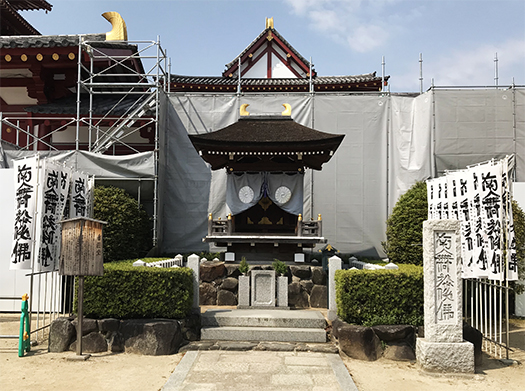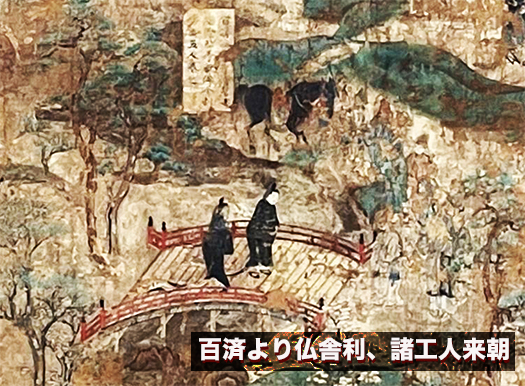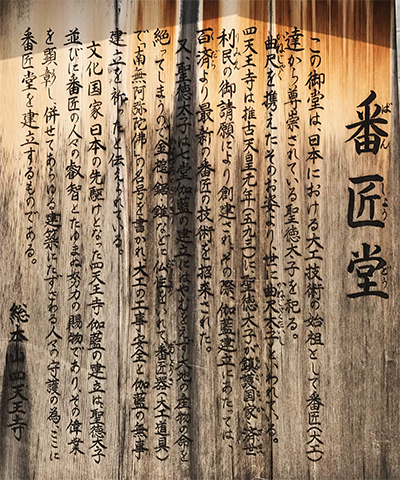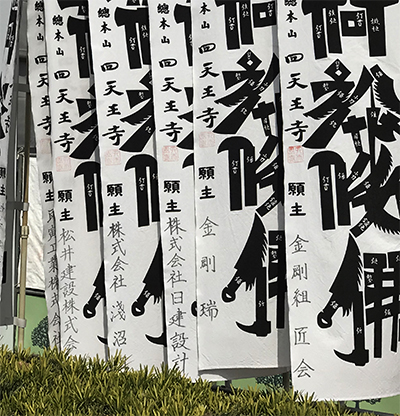

「法隆寺宝物館「聖徳太子絵伝」についての記事、第9回目は創業・西暦578年、日本最古の建築技術集団「金剛組」の聖徳太子との機縁の開示であります。
このシリーズの第一回はこちら→端正なモダニズム「法隆寺宝物館」探訪。
聖徳太子絵伝の分析でこの日本最古の建設会社の事跡が紹介されているとは思わなかった。まさかの驚きの瞬間であります。写真上は四天王寺の本堂裏手にある番匠堂。通称「曲尺太子」。聖徳太子が大工道具である「曲尺」を手に持たれている姿が現されている。
わたし自身全国の工務店との連携の中で住宅雑誌人として仕事人生を継続してきたので、その取材対象としての建築人がリスペクトする存在として金剛組については思い入れもあり、2018年の関西取材出張の折には親会社にも訪問した経験がある。大工職には聖徳太子の縁が深く絡んでいる。同社のHPには以下の記述。
「聖徳太子の命を受けて、海のかなた百済の国から三人の工匠が日本に招かれました。この内の一人が、金剛組初代の金剛重光です。工匠たちは日本最初の官寺である四天王寺の建立に携わりました。重光は四天王寺が一応の完成をみた後もこの地に留まり、寺を護りつづけます」
聖徳太子の生年は572年とされるので、この創業年と太子との関連についてはもう少し調査をしたい。この「番匠堂」の説明記述では593年にこの四天王寺建立と書かれているので、来日と創業年には若干のズレがある。そうすると金剛組組織は朝鮮・百済の地で創業したのかも知れない。
「今度、倭国で四天王寺という本格的な仏教寺院が創建される。ついては専門技術者の派遣が要請された。この事業を担う有為な人材を求める」という専門職人リクルート活動が百済で行われ、新興国家での仏教寺院フロンティアに身を捧げたいと考えた「工人」たちによって組織が作られたのかも知れない。


この金剛組の主たる目的が四天王寺の建立とその後の「宮大工」としての仏教建築創建・維持発展への貢献。日本に仏教建築の作法、王道を伝える上で欠かすことの出来ないエピソードでしょう。釈迦の墓とされる仏塔が五重塔などで表現され、また瓦などの建築部材文化が華麗に導入された。それぞれに専門技術が集約されて「組」という組織形態を形成していた。技術としても組織としても宗教建築の基盤が導入された。
もちろんこの建設事業は国家プロジェクトであり広く国内の建設技術者たちも動員されたに違いない。かれらは百済から来た工人たちと力を合わせて取り組む内にさまざまな技術の相互交流・昇華があったに違いない。日本社会はこうしてもたらされた技術を進化発展させていったけれど、大陸・半島では木造技術はその後苦難に遭遇していく。今日、彼の地での大型木造建築の維持発展には日本の技術が「恩返し」輸出されている。
わたし自身の探訪ブログとしても、過去の取材事実と今回の聖徳太子絵伝シリーズとが交叉してくれてまことに感激的(笑)であります。
English version⬇
Carpentry group “Kongo Gumi” came to Japan from Baekje to build Shitennoji Temple, The Gallery of Horyuji Treasures-9]
The experience of visiting Shitennoji Temple and the Kongo Gumi crossfires with the pictorial biography of Prince Shotoku. Encounter with frontier spirits of East Asian architectural culture. …
The ninth article in the series on “The Illustrated Biography of Prince Shotoku” in the Gallery of Horyuji Treasures discloses the relationship between Prince Shotoku and the Kongo-gumi, Japan’s oldest architectural engineering group founded in 578 A.D.
I had no idea that an analysis of Prince Shotoku’s pictorial biography would introduce the traces of this oldest construction company in Japan. It is a moment of surprise. The photo above is Banshodo, located behind the main hall of Shitennoji Temple. It is commonly known as “Kyokushaku Taishi. It is said to represent Prince Shotoku holding a carpenter’s tool called “kyokusaku” in his hand.
I have been working as a housing journalist in cooperation with construction companies all over Japan, and I have a strong attachment to Kongo Gumi as an entity that architects respect as a subject of their coverage, and I have visited the parent company when I was in Kansai in 2018. The carpentry profession has a deep connection with Prince Shotoku. The company’s website states the following.
Under the order of Prince Shotoku, three carpenters were invited to Japan from the country of Baekje, far across the sea. One of them was Shigemitsu Kongo, the founder of the Kongo Gumi. These craftsmen were involved in the construction of Shitennoji Temple, the first official temple in Japan. After the completion of Shitennoji, Shigemitsu remained in the area and continued to protect the temple.
Since Prince Shotoku is said to have been born in 572, we would like to do more research on the relationship between this founding year and Prince Shotoku. The description of the “Banshodo” states that the Shitennoji temple was built in 593, so there is a slight discrepancy between the date of arrival and the year of foundation. If so, the Kongo-gumi organization may have been founded in Baekje, Korea.
The “Shitennoji Temple, a full-fledged Buddhist temple, is to be built in Japan. The temple was to be built in Japan, and the dispatch of professional engineers was requested. The organization may have been established by “craftsmen” who wanted to devote themselves to the frontier of Buddhist temples in the newly emerging nation.
The main purpose of the Kongo Gumi was the construction of Shitennoji Temple and its subsequent contribution to the creation, maintenance, and development of Buddhist architecture as “palace carpenters. This episode is indispensable in conveying to Japan the manners and highways of Buddhist architecture. The five-story pagoda, which is believed to be the tomb of Buddha, was represented in the five-story pagoda and other pagodas, and the culture of building components such as roof tiles was introduced in a splendid manner. Specialized techniques were concentrated in each of them, forming an organizational form called “kumi. The foundation of religious architecture was introduced both in terms of technology and organization.
Of course, this construction project was a national project, and construction engineers from all over the country must have been mobilized. As they worked together with the Baekje workers, there must have been a mutual exchange and sublimation of various technologies. While Japanese society evolved and developed the technology thus brought to them, wooden technology encountered difficulties on the continent and peninsula. Today, Japanese technology is being exported “in return” for the maintenance and development of large wooden structures in the region.
As for my own blog of exploration, I am very impressed by the intersection of my past research and this series of Shotoku Taishi E biographies.







コメントを投稿
「※誹謗中傷や、悪意のある書き込み、営利目的などのコメントを防ぐために、投稿された全てのコメントは一時的に保留されますのでご了承ください。」
You must be logged in to post a comment.